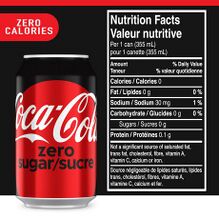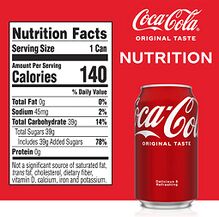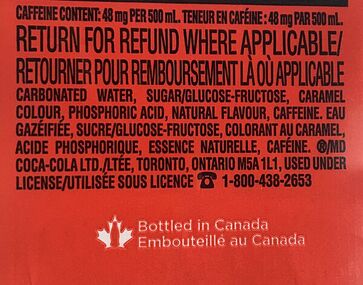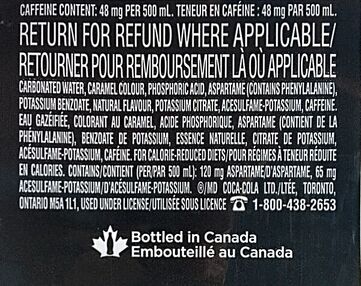Course:FNH200/Assignments/2022/Coke Regular Zero

Introduction[1]
Coca-Cola is one of the most popular soft drinks in the world. The Coca-Cola Company sells a range of products, including regular Coca-Cola, Diet Coca-Cola and Coca-Cola Zero Sugar. While these products all taste similar, they contain different sweeteners. Some of these sweeteners are meant to be low in calories.
Coke Zero, which has recently been rebranded as Coca-Cola Zero Sugar, is marketed as a healthier version of the original sugar-sweetened beverage, Coca-Cola Classic.
It contains zero calories and sugar while providing the signature Coca-Cola flavor, making it an appealing drink among those trying to reduce their sugar intake or control their weight.

Though Coke Zero is sugar-free, its artificial sweeteners are controversial. Still, research on the effects of artificial sweeteners on diabetes risk is mixed, and more studies are needed to fully understand a possible connection. Therefore Coke Zero does not add nutritional value to diet, and the long-term effects of drinking diet sodas are still unclear.
Ingredient lists
| Ingredients | Identify fat substitutes, sugar Substitutes, additives | roles of fat substitutes, sugar substitutes, and/or additives (functional property) |
|---|---|---|
| Carbonated Water | N/A (Solvent) | Main ingredient (90+%): gives the drink its “bubbles” or “fizz”[1] |
| Sugar (glucose-fructose) | Additive | A sweetening agent + natural preservative[1][2] |
| Caramel colour | Additive | Provides Coke’s unique brown/dark colour[1] |
| Phosphoric acid | Additive | Provides the tartness taste[1] |
| natural flavour | Additive | Provides Coke’s unique flavor[1] |
| caffeine | Additive | A stimulant + contributes a characteristic bitter flavor [1] |
| Ingredients | Identify fat substitutes, sugar Substitutes, additives | roles of fat substitutes, sugar substitutes, and/or additives (functional property) |
|---|---|---|
| Carbonated Water | N/A (Solvent) | Main ingredient (90+%): gives the drink its “bubbles” or “fizz” |
| caramel colour | Additive | Provides Coke’s unique brown/dark colour |
| phosphoric acid | Additive | Provides the tartness taste |
| aspartame (contains phenylalanine) | Sugar substitute | substitutes sugar: low-calorie sweetener[2][3] |
| potassium benzoate | Additive | A preservative[3][4] |
| natural flavour | Additive | Provides Coke’s unique flavor |
| potassium citrate | Additive | A buffering agent to help regulate tartness [3][5] |
| acesulfame-potassium | Sugar substitute | A synergetic sweetener (used with aspartame)[2][3] |
| caffeine | Additive | A stimulant + contributes a characteristic bitter flavor |
Two major differences between the regular coke and Zero coke include:
- Substitution of sugar in regular Cokes by sweeteners (Aspartame + acesulfame-K) for Zero Cokes. Thus, Zero Cokes do not contain any calories (0 calories vs 140 calories in regular cokes) nor any carbohydrates (0g vs 39g in regular cokes) in a 355ml can. Since Aspartame is 180-220 times sweeter than sucrose, very small amount of the sweetener is required to generate sweetness. Moreover, it is a low-calorie sweetner (4cal/g). Accordingly, Zero cokes can be an attractive option for patients with diabetes or individuals concerned with calorie intakes. However, patients with PKU (phenylketonuria)[2] should avoid Aspartame consumption. Meanwhile, the other sugar substitute, acesulfame-K, is a synergetic sweetener that is approximately 200 times sweeter than sucrose and is non-caloric. It is often used with aspartame to add sweetness in beverages and has high stability in pH and temperature changes.
- Addition of potassium benzoate (preservative) and potassium citrate (buffering agent) to Zero Cokes. Since these sweeteners do not possess preservative properties like natural sugar, the manufacturer has added a preservative to inhibit microbial growth. Moreover, potassium citrate is added to adjust the tartness taste in Zero Cokes.
Other ingredients (including carbonated water, caramel colour, phosphoric acid, natural flavor, and caffeine) in Zero Cokes are the same as regular Cokes and serve the same roles.
Labels
- Coca-Cola ( Based on 355ml can)
- 140 calories
- 45mg of sodium ( 2% of total daily value)
- 39g of carbohydrate (14% of total daily value)
- It is not a significant source of saturated fat, trans fat, cholesterol, dietary fiber, vitamin D, calcium, iron and potassium
- Coka-Cola Zero (Based on 355ml can)
references
Please use the Wikipedia reference style. Provide a citation for every sentence, statement, thought, or bit of data not your own, giving the author, year, AND page.
Note: Before writing your wiki article on the UBC Wiki, it may be helpful to review the tips in Wikipedia: Writing better articles.[6]
| This Food Science resource was created by Course:FNH200. |
- ↑ 1.0 1.1 1.2 1.3 1.4 1.5 1.6 "What are the ingredients of Coca‑Cola Classic?". CocaCola Great Britain. 10/01/2020. Retrieved 7/19/2022. Check date values in:
|access-date=, |date=(help) - ↑ 2.0 2.1 2.2 2.3 Chan, Judy (July 16, 2021). "Lesson 3". UBC Wiki. Retrieved July 19, 2022.
- ↑ 3.0 3.1 3.2 3.3 "Coca-Cola® Zero Sugar: Nutritient Facts". Coca-Cola Canada. Retrieved 07/19/2022. Check date values in:
|access-date=(help) - ↑ "What Is Potassium Benzoate? Uses, Foods, and Side Effects". Healthline. 09/22/2020. Retrieved 07/19/2022. Check date values in:
|access-date=, |date=(help) - ↑ "Potassium Citrate in Food Production". Bell Chem. 10/04/2021. Check date values in:
|date=(help) - ↑ En.wikipedia.org. (2018). Writing better articles. [online] Available at: https://en.wikipedia.org/wiki/Wikipedia:Writing_better_articles [Accessed 18 Jan. 2018].


